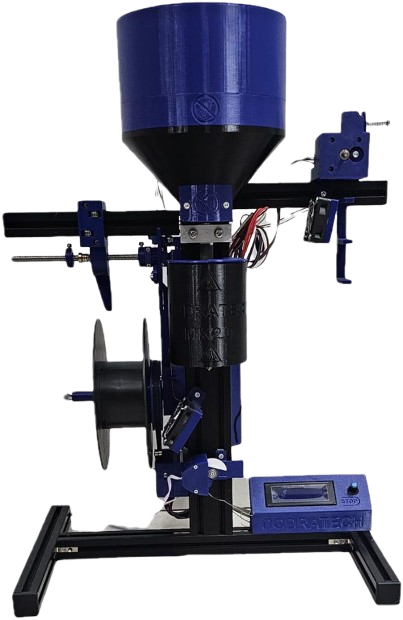Desktop Filament Extruder
Are you looking to streamline your 3D printing workflow, explore new polymer materials, or optimize your research on filament production? Our Desktop Filament Extruder is the ideal solution for academic institutions, cutting-edge research labs, and professional innovators. Meticulously designed to be both compact and user-friendly, this desktop extrusion system enables you to transform plastic pellets, shredded 3D printing waste, or experimental polymers into reliable 3D printing filament with minimal hassle.
Why Choose a Desktop Filament Extruder
In today’s ever-evolving world of 3D printing, research facilities need agile, desktop-scale equipment that can handle custom materials, experimental blends, and rapid prototyping demands. Traditional commercial filaments often limit your creativity—or come at a significant cost when you’re iterating and testing repeatedly. By operating your own Desktop Filament Extruder, you gain:
- Complete Control Over Material Composition: Fine-tune polymer blends, additives, and colorants to match your research goals.
- Cost Efficiency: Recycle leftover prints or test with cost-effective pellets to save on production expenses.
- Eco-Friendly Advantage: Repurpose 3D printing waste and reduce your lab’s environmental footprint.
- Customizable Filament Diameter: Produce either 1.75 mm or 2.85 mm filament based on your printer requirements.
- Compact Footprint: Perfect for labs, offices, and classrooms with limited space.
Key Features & Benefits
-
Desktop-Friendly Design
- Dimensions: 486 mm wide, 406 mm deep, and 654 mm high.
- Occupies minimal bench space, ideal for research labs, university departments, or small R&D offices.
-
High Precision Filament Control
- Filament Diameter Accuracy: ±0.05 mm (pellets) / ±0.07 mm (shredded waste).
- Achieve reliable diameter tolerances critical for scientific experiments and precision 3D prints.
-
Dual Extruder Screw Options
- Compression Ratio: 3:1 or 2:1; Extruder Screw Diameter: 12 mm.
- Customize your setup for various materials—high compression for shredded plastic or low compression for pellets.
-
Wide Material Compatibility
- Tested with PLA, ABS, and PETG.
- Maximum temperature of 260°C, suitable for multiple thermoplastic polymers.
-
Sustainable Filament Production
- Process shredded 3D printing waste or regrind, reducing landfill and saving costs.
- Built-in melt filter (optional) to remove minor impurities.
-
Compact Yet Powerful Motor System
- Gear Ratio: 15.8:1 (using both a toothed belt and an eccentric cycloid gear).
- Maximum Speed: 25 RPM at 7 NM torque—up to 400 grams/hour without calibration or filter (3 mm nozzle).
-
Automatic Winding & Calibration
- Produces stable filament arcs for consistent spool winding.
- Spool capacity supports up to 2 kg, with a maximum spool diameter of 300 mm.
-
Indoor-Only, CE-Compliant Operation
- Designed for controlled lab or workshop environments: 19–27°C ambient temperature, up to 70% humidity.
- Comes with an AC/DC switching power supply (24V, 5.00A, 120W max), compliant with Part 15 of the FCC Rules.
-
Easy Setup & Maintenance
- Straightforward assembly for connecting power, loading pellets, and calibrating diameter.
- Robust, 3-zone extruder screw design ensures smooth flow and minimal clogs.
-
Professional Support & Documentation
- Includes user guides, technical manuals, and a knowledge base for advanced troubleshooting.
- Essential for academic research where clarity and repeatability are paramount.
Detailed Product Description
The Desktop Filament Extruder stands at the forefront of research equipment designed to transform how institutions handle 3D printing materials. By integrating a durable stainless steel extruder screw (available in 3:1 or 2:1 compression ratios) with a precisely controlled stepper motor, this machine effortlessly melts and extrudes a range of thermoplastics—from PLA pellets to shredded PETG waste.
Engineered to fit on a standard lab workbench, its compact frame (486 mm W × 406 mm D × 654 mm H) belies a powerful system that can reach up to 260°C. At a maximum extrusion speed of 25 RPM, you can produce up to 400 grams of filament per hour under optimal conditions (3 mm nozzle, no melt filter). For typical research scenarios—using the built-in melt filter and calibrating to 1.75 mm or 2.85 mm—the extruder yields 150–300 grams/hour, around 4–7 hours for 1 kg of consistently measured filament.
With integrated temperature control, spool winding, and filament calibration, you can maintain stable diameters. A sensor-driven feedback loop adjusts the spool motor speed based on the filament arc, ensuring each spool is wound neatly.
In addition to standard pellets, the extruder can handle regrind or shredded 3D printing waste, offering a sustainable route to plastic recycling. For academic institutions, it’s an invaluable teaching tool where students can witness how parameters—like temperature, speed, or nozzle size—impact filament properties.
Why Researchers Love It
- Versatility: Switch between experimental filaments or standard materials in minutes.
- Control: Fine-tune compression ratio and melt temperature.
- Cost Reduction: Lower reliance on expensive commercial filaments, beneficial for frequent testing.
- Eco-Conscious: Reduce lab waste by recycling prints directly into new filament.
Technical Specifications
| Product Name | Desktop Filament Extruder |
| Category | Research Equipment |
| Filament Diameters | 1.75 mm and 2.85 mm |
| Max Extrusion Speed | 25 RPM (7 NM torque) |
| Extrusion Performance |
Up to 400 g/hour without calibration or melt filter (3 mm nozzle, tested with PLA at 210°C) 150–300 g/hour with standard calibration & melt filter (1.7 mm nozzle) |
| Production Speed | 0.7–1.6 m/min |
| Compression Ratios | 3:1 or 2:1 (Extruder Screw Ø12 mm, L/D 10:1) |
| Nozzle Temp Range | Up to 260°C |
| Dimensions (W×D×H) | 486 × 406 × 654 mm |
| Weight | 8.75 kg (gross) / 6.9 kg (net) |
| Power Supply | 100–240 VAC, 50/60 Hz, 2.0 A / Output 24 V, 5.00 A, 120 W max (FCC Part 15–compliant) |
| Fuse | SMD fuse, soldered |
| Operating Env | 19–27°C, up to 70% humidity; indoor use only |
| Max Spool Size | 2 kg spool (300 mm diameter, 100 mm width) |
| Diameter Accuracy | ±0.05 mm (pellets), ±0.07 mm (shredded waste) |
| Typical Materials | PLA, ABS, PETG (others possible with correct settings) |
| Gear Ratio (Motor) | 15.8:1 (two-stage gear system) |
| Safety & Compliance |
Indoor use only SMD fuse for overcurrent protection CE considerations for electronics & mechanical assembly |
Frequently Asked Questions (FAQ)
Q1: Which materials can I extrude besides PLA, ABS, and PETG?
The extruder can generally process any thermoplastic with a melting point below 260°C, including certain Nylons, PP, and TPU with appropriate temperature and feeding adjustments. Final results may vary based on cooling behavior and material fluidity.
Q2: How long does it take to produce 1 kg of filament?
Under typical conditions—using 1.7 mm or 1.75 mm nozzles, a melt filter, and standard calibration— expect around 4–7 hours per kilogram. Higher throughput (up to 400 g/hour) is possible with a larger nozzle diameter and fewer calibration constraints.
Q3: Is it difficult to switch from pellets to shredded waste?
Simply empty and clean the hopper, purge the previous resin, and adjust compression or nozzle settings as necessary. Consistency in shredding size and dryness is key to optimal filament quality.
Q4: Do I need special power requirements in my lab?
The power supply adapts to 100–240 VAC, 50/60 Hz. A standard outlet with up to 2.0 A capacity is sufficient, providing 24 V, 5.00 A, up to 120 W output.
Q5: How do I ensure filament diameter accuracy?
Use built-in calibration features, maintain consistent hopper loading, and precisely control extrusion temperature. A sensor measures filament arc position, automatically adjusting pull speed for stable diameters.
Q6: What safety features are included?
The extruder has an SMD fuse for overcurrent protection, a robust mechanical frame, and recommended operational guidelines. Use in a well-ventilated area and monitor temperatures to avoid overheating.
Q7: How do I learn more about customization or troubleshooting?
Our technical documentation and customer support team can guide you for advanced research needs. Explore our blog for step-by-step tutorials, polymer insights, and case studies.
Learn More – Visit Our Blog
Ready to dive deeper into the science behind filament extrusion, best practices for shredded material, or advanced polymer research techniques? Check out our Blog for in-depth articles, success stories from research labs, and insights on future filament technology. From mastering temperature profiles to designing novel polymer blends, our blog keeps you at the forefront of 3D printing innovation.
This Desktop Filament Extruder is originally designed by David Pfeifer from ARTME 3D, whose work has significantly advanced open-source 3D printing technology. Before purchasing or using this extruder, please review the License & Usage Terms to understand your rights and responsibilities. By proceeding, you agree to comply with all CC BY-SA, CAD file, and GPL firmware requirements.







